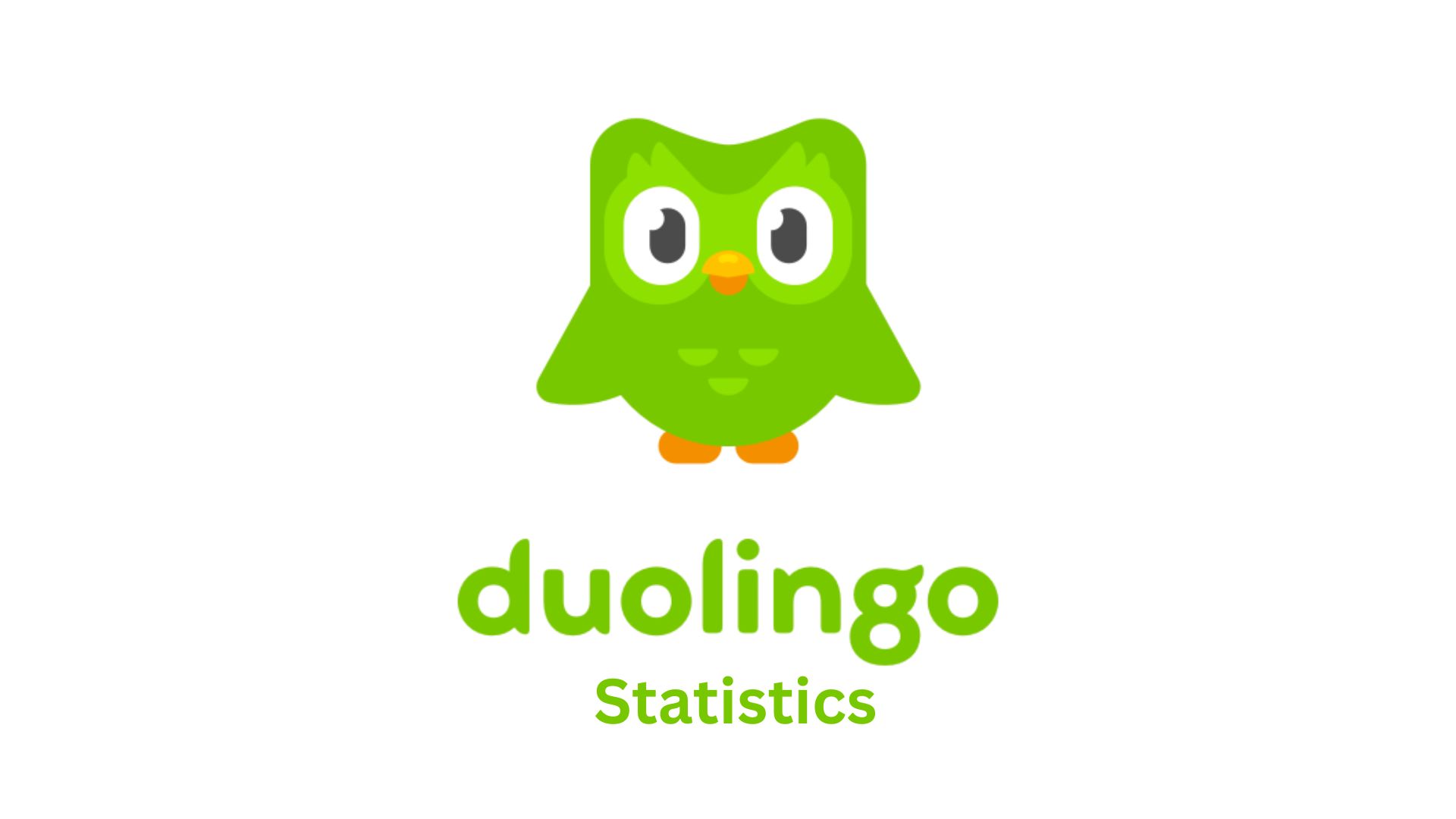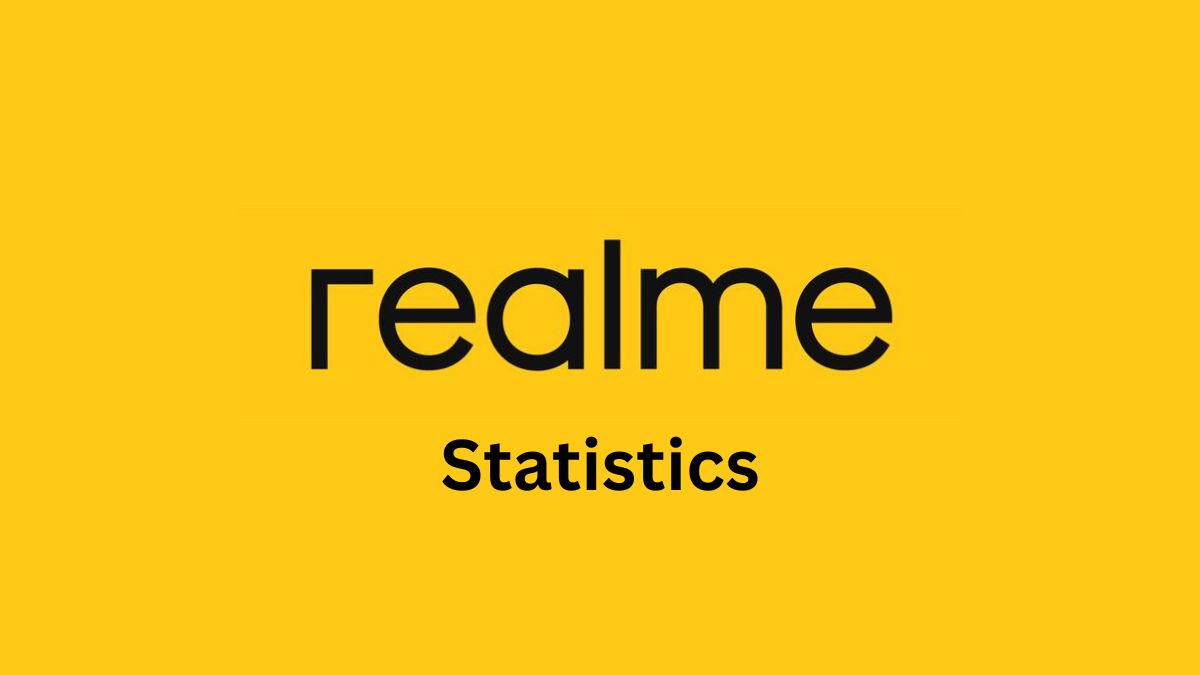Basecamp Statistics and Facts (2025)
Updated · Mar 25, 2025
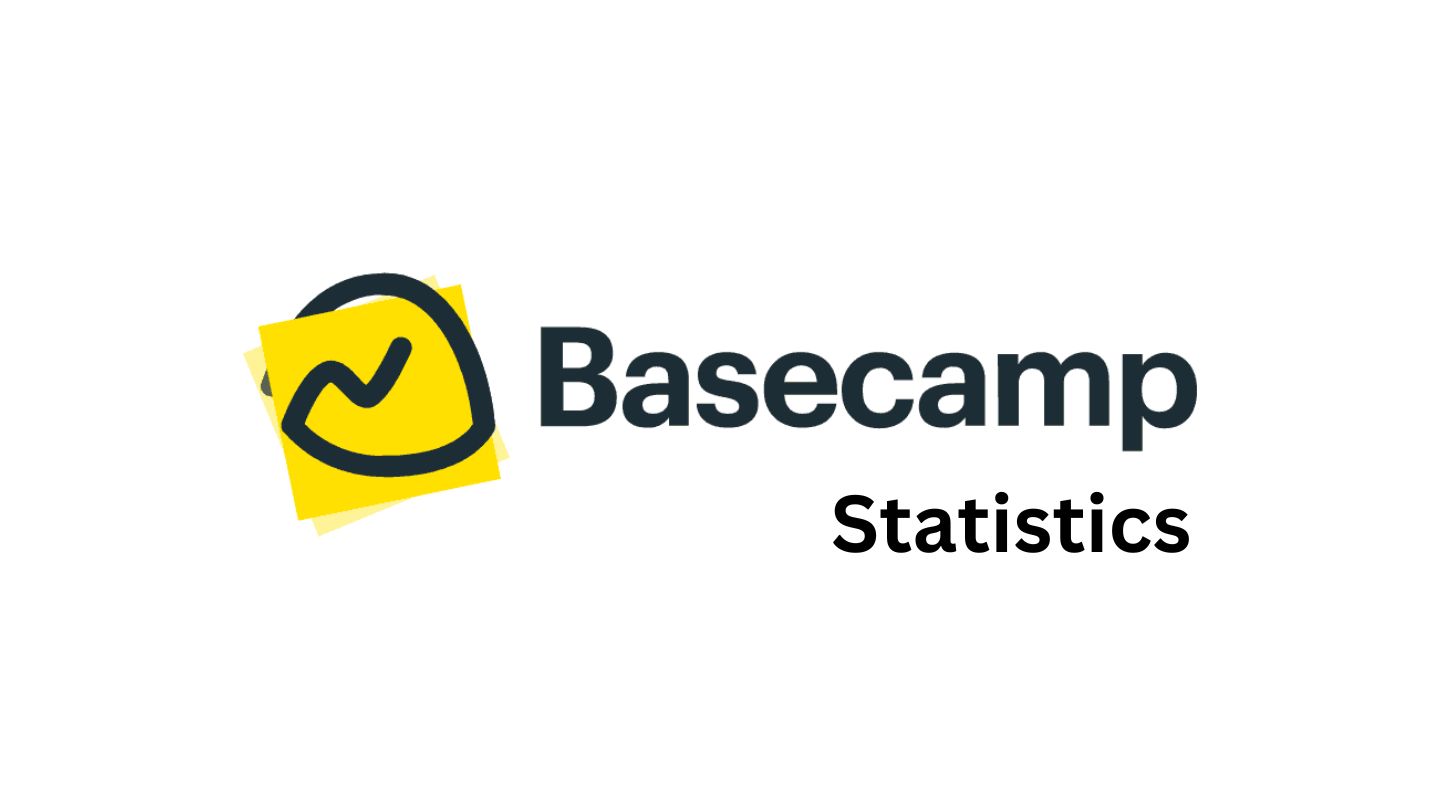
Table of Contents
Introduction
Basecamp Statistics: Basecamp is a webified project management and team collaboration software and has played a pivotal role in streamlining the workflow of organisations around the world. Based in Chicago, Illinois, it was founded in 1999 by Jason Fried, Carlos Segura, and Ernest Kim, and it aims to provide tools that can better the productivity of teams through an entire infrastructure of apps, which includes to-do lists, message boards, calendars, file sharing, and real-time group chat.
Over the years, it has become the preferred option for companies trying to run projects more organizedly. In this article, we examine Basecamp’s statistics regarding its user community, revenue increase, employee strength, and market presence.
Editor’s Choice
- According to Basecamp statistics, the company generated revenue of USD 280 million in 2024, an increase of 7.47% from preceding years.
- Basecamp has experienced continuous growth since 2003, with revenue rising from USD 43.7 million in 2012 to USD 215.6 million in 2020.
- The company operates with 171 employees, 37 of whom are engineers, representing 22% of its total workforce.
- It is being used by around 75,000 companies, with 3.3 million users worldwide.
- Basecamp statistics state that 2,52,000 customers are being served by Basecamp, which is a testament to its adoption.
- Financially, on the downside, Basecamp reported net liabilities in the amount of £6856, which indicates a 2024 financial deficit.
- Traffic by Country: U.S. 45.51%, India 6.50%, U.K. 5.53%.
- 77% of its customers are based in the U.S., followed by Canada at 6.57% and India at 5.37%.
- For them, direct traffic (80.10%) is the largest marketing channel, whereas organic search (15.81%) is second to that.
- Basecamp statistics show that social media channels drive negligible referrals, with YouTube (39.10%) being the biggest contributor, followed by LinkedIn (16.34%) and Facebook (15.23%).
- Gender is almost equally divided: 48.65% female and 51.35% male users.
- The most significant user demographic is 25-34 years (26.30%), followed by 35-44 years (20.76%).
- 14% of Basecamp’s users are from marketing and advertisement, while another 7% belong to the IT and higher education sectors.
Key Facts
- According to Basecamp statistics, Jason Fried, Carlos Segura, and Ernest Kim founded 37signals. It was originally a web design company, but due to high demand, it was increasingly difficult to organise and manage projects. This challenge led to the birth of Basecamp in 2003 as a purely internal project-management solution.
- The name 37signals was conceived from the 37 extraterrestrial radio signals identified by the astronomer Paul Horowitz. In 2014, the company pivoted away from 37signals to Basecamp and started focusing its allege on its flagship product.
- Over the years, Basecamp gained significant traction, and by 2013, it was the world’s most popular project management app, with over 8 million projects on its platform. Jeff Bezos, the founder and CEO of Amazon, also bought into Basecamp as a minority share through his investment company, Bezos Expeditions.
- Jason Fried, a co-founder of Basecamp, does not disclose the company’s revenue since he believes it’s irrelevant. He is also a fiery critic of venture capital, saying, “It kills more businesses than it helps.” Basecamp followed its monopoly on the matter: Free from lucrative financing offers from hundreds of financiers.
- In 2019, Fried was very aggravated to see his competitors’ ads for the term “Basecamp” appear in Google results just above his own website. He denounced Google for its “shakedown” advertising model, which forced him to buy Google Ads to protect his own trademark.
- In 2020, Basecamp put Hey! on the market, a premium email service that is integrated with the Basecamp platform but functions as a separate mobile application. The same year sparked another uproar against Apple’s App Store policies when they demanded Basecamp enable an in-app purchase option in order to avoid the Hey! iOS app from being taken down from the App Store.
Basecamp Revenue
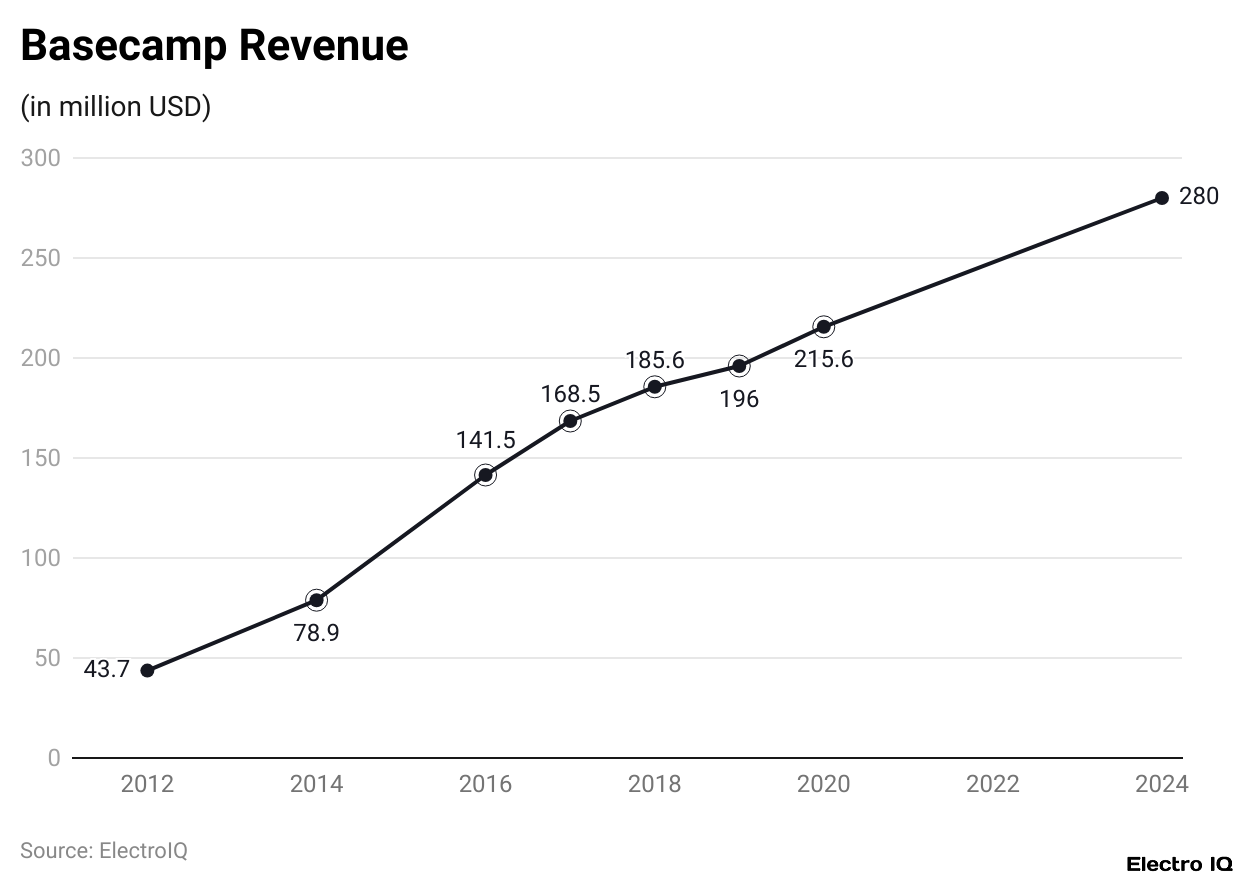
(Reference: getlatka.com)
- Since its inception in 2003, Basecamp has embraced a steady revenue stream. In its first year, the company had zero revenues, but over time, Basecamp grew into quite substantial financial dimensions. 2012 estimates by Basecamp show that revenues were around USD 43.7 million, which nearly doubled to over 78.9 million dollars in 2014.
- The upward trend continued, reaching 141.5 million in 2016 and USD 168.5 million in 2017.
- By 2018, revenues had reached USD 185.6 million, and in 2019, this increased by another USD 196 million. Basecamp reached USD 215.6 million in revenue in 2020, reflecting continuing strength in the financial area.
- Basecamp statistics state that by 2024, Basecamp’s revenue is expected to have grown by various marks, amounting to USD 280 million from last year’s figure. This has also made a massive claim of growth at around 7.47% within one year.
- All these statements emphasize the company’s need to maintain a very strong market presence and the constant demand for its project management solutions.
Basecamp Number of Employees
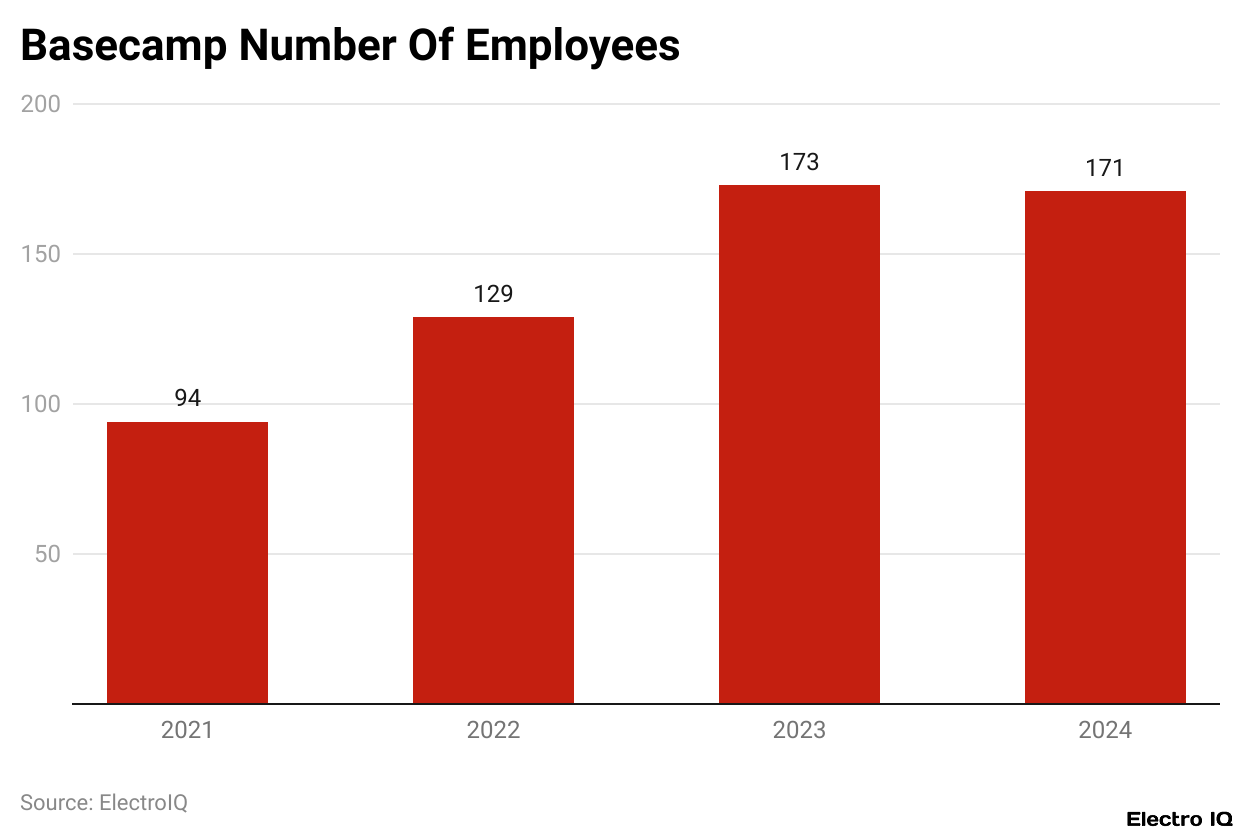
(Reference: getlatka.com)
- Basecamp statistics show that Basecamp operates a total of 171 employees, supporting its customer base of more than 252,000 clients.
- Among these, 37 employees comprise the engineering department, representing about 22% of the overall workforce.
- This proportion underlines the company’s emphasis on technical development and product improvement, which ensures a strong engineering force to maintain and develop its platform.
Basecamp User Adoption
- Basecamp statistics show that in 2024, It will still be a powerful project management tool with a vast user base. About 75,000 companies currently use the website, demonstrating its wide reach and acceptance across industries.
- More than 3.3 million individuals worldwide use Basecamp, and many of them prove the platform’s reliability and effectiveness for team collaboration.
- About 252,000 customers use the platform, which shows a solid presence in the market and consistent demand from companies looking for better project management solutions.
Basecamp Financial Highlights
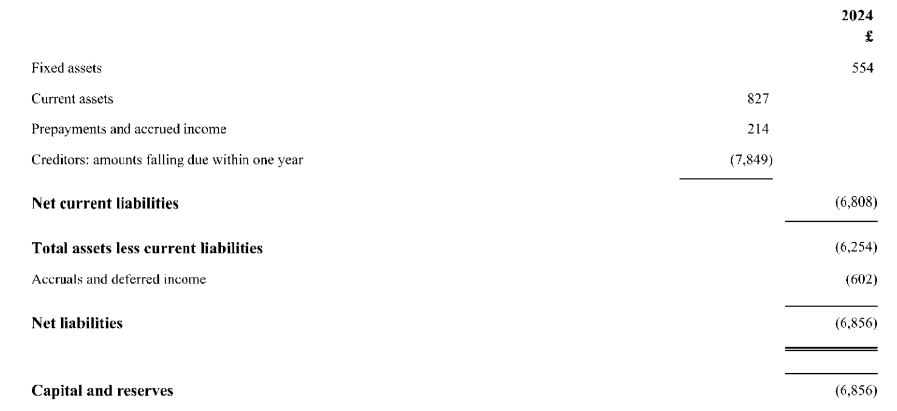
(Source: amazonnaws.com)
- Basecamp statistics reveal that the financial analysis of Basecamp in 2024 will examine how the company’s asset structure, liabilities, and general financial health structure.
- The company currently has £554 under fixed assets, with current assets amounting to £827.
- The company also valued prepayments and accrued income at £214, while its short-term financial commitments were less aggressive.
- Creditors were owed £7,849 within the space of just one year.
- Therefore, net current liabilities stood at £6808, a direct indication that the company’s short-term debts were more liquid than its liquid assets.
- Hence, total assets after deducting current liabilities were £ 6254. Other financial adjustments include accruals and deferred income of £602, resulting in net liabilities of £6856.
- This figure is also seen in the company’s capital and reserves and indicates the financial deficit of that amount.
- Thus, it indicates that Basecamp operated at a net loss in 2024 when liabilities became greater than assets.
Basecamp Website Traffic By Country
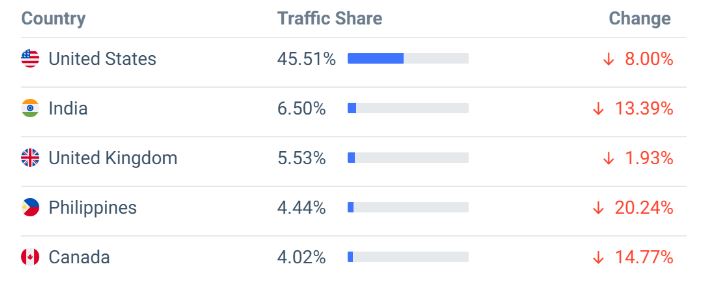
(Source: similarweb.com)
- According to Basecamp statistics, Basecamp’s website traffic primarily comprises users from the United States at 45.51% of total traffic. However, this has decreased by 8.00%, suggesting that the region is losing engagement.
- The next traffic miner in India, with 6.50%, recorded a maximum drop of 13.39%. The United Kingdom, with 5.53%, posted a marginally lower drop at 1.93%.
- The Philippines accumulated 4.44% of traffic but suffered a considerable 20.24% drop, the highest among the countries listed. Canada provided 4.02% of the total traffic, which shows a minus 14.77% decrease.
- All these alterations suggest an overall downward trend for site visits in various regions.
Basecamp Marketing Channels
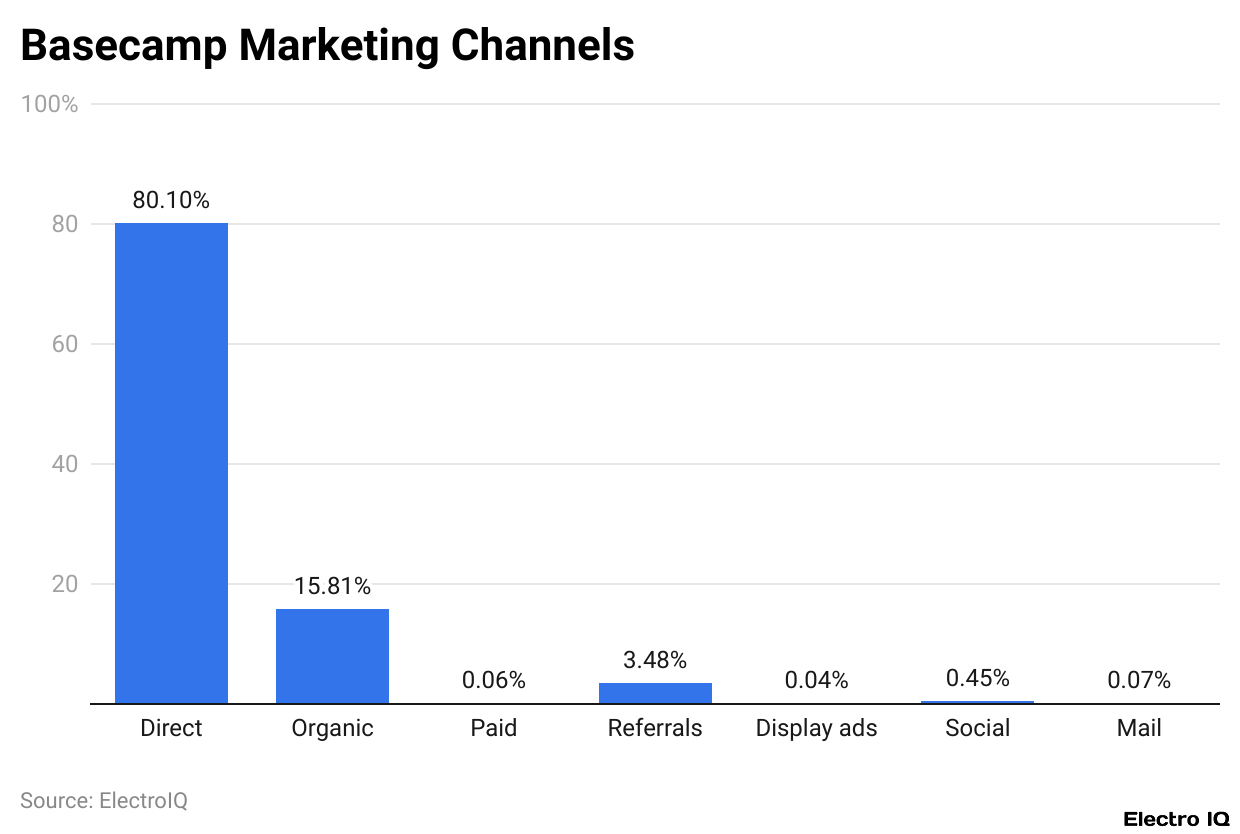
(Reference: similarweb.com)
- Basecamp statistics show that the other traffic sources for Basecamp evidently show that marketing relies heavily on direct traffic, with 80.10% of users having access directly to the platform. This factor indicates solid brand recognition as well as a loyal client base.
- Also, organic search accounts for 15.81%, suggesting that many users find Basecamp via search engines without paid promotions.
- The input-wise importance of paid marketing is minimal, contributing only 0.06%, while referrals from other websites comprised 3.48%, thereby indicating some level of endorsement from others.
- Display ads bring in just 0.04%, which suggests that the company does not focus on them much.
- Social media, with 0.45%, and email marketing, with a meagre 0.07%, contribute little to Basecamp’s traffic generation.
- Therefore, the emphasis seems to be on direct traffic and organic search, which further suggests that aggressive ads are not part of their traffic generation strategy.
Basecamp Social Traffic
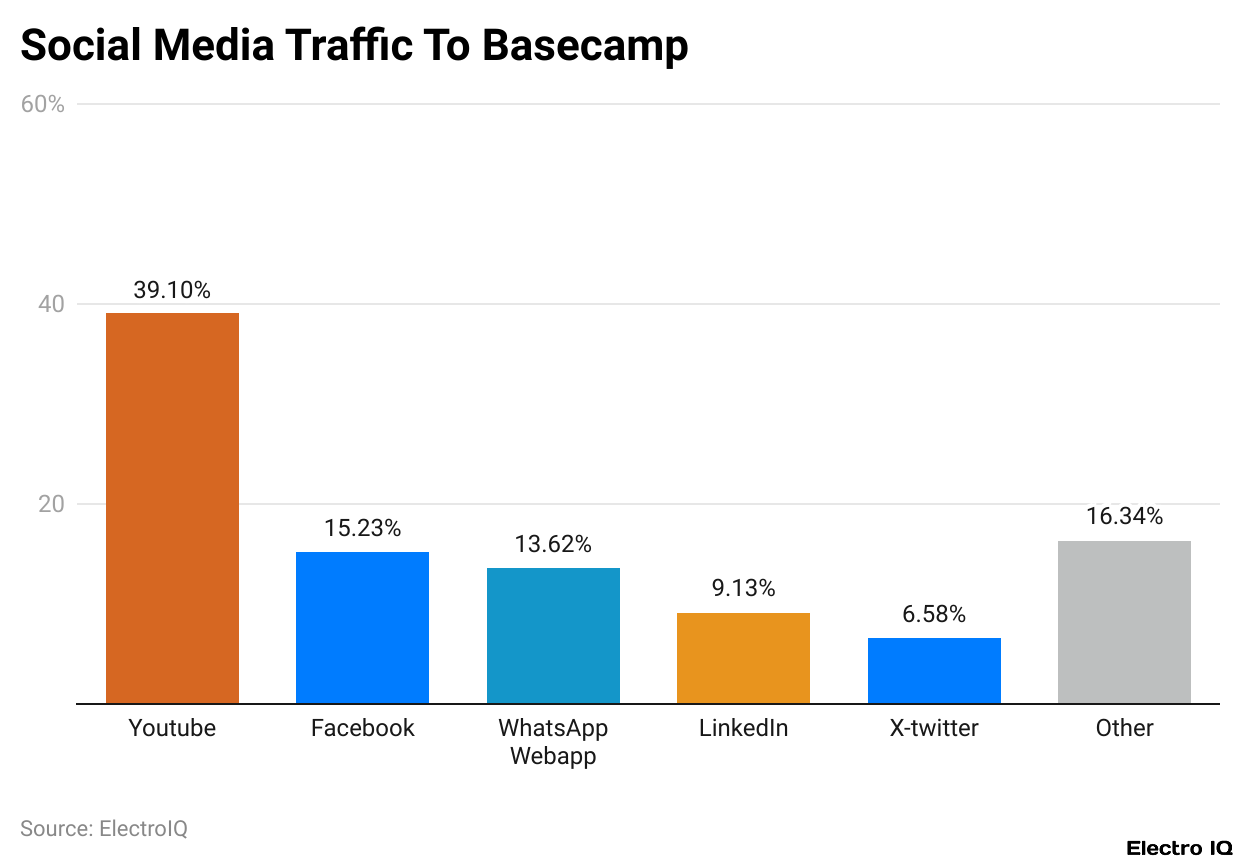
(Reference: similarweb.com)
- Basecamp’s website traffic from social media sources comes from different platforms. Out of these, YouTube was the best performer, with 39.10% of total social traffic, meaning there is an engaging video content program.
- LinkedIn follows with 16.34% social traffic, an indication of its presence among professionals and businesses.
- With the remaining 15.23%, Facebook shows considerable traffic both among common users and organisations.
- WhatsApp had a share of 13.62%, representing the importance of direct messaging and group communications in traffic generation.
- Traffic from social discussion and updates on X (formerly Twitter) account for 9.13%, with many visitors still trickling through.
- The remaining 6.58% comes from other social platforms, which adds stability to Basecamp’s online reach.
Basecamp Demographics

(Source: similarweb.com)
- Basecamp shows a highly bifurcated demographic of users, with almost half of the users, 48.65%, identifying as female and 51.35% as male.
- The user base’s age distribution ranges from 18-24 onwards, with the most significant population segmentation of active users being 25-34 years of age, accounting for 26.30% of the capacity.
- The 35-44-year-old cohort comes next, with 20.76%, while 15.68% are 45-54 years old.
- The younger population between the 18-24 age category consists of 14.09%, while the 55-64 and 65+ years old categories represent 14.05% and 9.12%, respectively.
- Basecamp statistics underline the fact that It has been embraced as a solution by professionals of all levels in their careers, with the highest concentration from those nearing the end of their careers.
Basecamp’s Market Reach And Competitive Landscape
- Basecamp statistics reveal that It is indeed a contender in nearly any sector and region. Of the businesses that use Basecamp, 14% work in marketing and advertising, making it an evidently effective platform for managing creative projects.
- The information technology and services industry then makes up just 7% of users involved with that technology and goes on about its relevance in the tech-driven environment.
- Similarly, just another 7% use Basecamp in the higher education sector, showcasing its adaptability in academic project management.
- On the geographic front, the US is in the lead, with 77% of Basecamp’s customer base reflecting a dominant domestic concern. Canada and India complete that with 6.57% and 5.37% of that web traffic respectively.
- In terms of annual coverage and user numbers, Basecamp boasts over 520,000 unique visitors daily, which translates to around 15.9 million unique users.
- The average session lasts about 13 minutes and 58 seconds, which shows a high level of engagement with the platform’s features.
- Though it is massively present in the market, Basecamp is still competitive. For instance, it faces competition from Asana, which is primarily for task management and collaboration, and Trello, which employs a card-like system for project organisation.
- ClickUp is a customisable workspace with multiple functionalities, while Notion is an app integrating note-taking, databases, and task management for a more versatile approach.
- Competition is always healthy, but with increased revenue and users, Basecamp keeps having a stronger footing within the market and customer loyalty.
Conclusion
According to Basecamp statistics, the company is one of persistence, growth, planning, and commitment to better visions of team collaboration. While moving through the dynamic needs imposed by project management, it would be the simple things—user engagement and customer-centric innovation—that will ensure Basecamp’s competitive advantage and immense success in the days ahead.
Sources
FAQ.
In 2024, Basecamp generated revenues of US$280 million, an increase of 7.47% from the previous year. The revenues have shown consistent growth with revenues reported at US$43.7 million in 2012 and steadily increasing since then.
Basecamp has around 3.3 million users around the world, while about 75,000 companies use the platform. The total number of customers on the platform stands at 252,000, indicating its huge presence in the market.
Basecamp has a total workforce of 171, with 37 engineers accounting for 22% of the workforce. This shows that the company values technical development and innovation quite a bit.
45.51% of traffic to Basecamp’s website comes from the United States, followed by India with 6.50% and the United Kingdom with 5.53%. However, traffic from these countries has seen a slight dip over the past few months.
Direct traffic (80.10%) plays a large role, indicative of a strong brand allegiance, while organic search contributes 15.81%, and lastly, quite an unremarkable chunk from social media is at 0.45%, the leading channel being YouTube (39.10%).

Joseph D'Souza founded ElectroIQ in 2010 as a personal project to share his insights and experiences with tech gadgets. Over time, it has grown into a well-regarded tech blog, known for its in-depth technology trends, smartphone reviews and app-related statistics.





